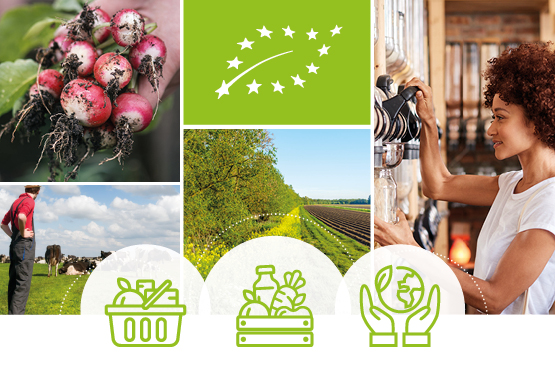In March 2021, the Commission launched an organic action plan for the European Union. The action plan sets out to achieve the European Green Deal target of 25% of agricultural land under organic farming by 2030.
The plan comprises of 23 actions divided across three axes:
- Axis 1: stimulate demand and ensure consumer trust
- Axis 2: stimulate conversion and reinforce the entire value chain
- Axis 3: organics leading by example: improve the contribution of organic farming to environmental sustainability
Axis 1: stimulate demand and ensure consumer trust
EU citizens increasingly value organic products. Based on the 2020 Eurobarometer survey on EU agriculture and the CAP, citizens believe that organic products are more likely to comply with specific rules on pesticides, fertilisers, and antibiotics (82% agreed), are more environmentally friendly (81%), and are produced with higher respect for animal welfare (80%). According to the survey, 56% of citizens recognise the organic logo, up from 27% in 2017.

Retail sales for organic products have increased by over 145% in the last 10 years, from approximately €18 billion in 2009 to €41 billion in 2019. On average, each European spends around €84 per year on organic products.
Increasing the consumption of organic products and strengthening consumers’ trust in organic products are vital elements in encouraging farmers to convert to organics. To support continued growth and maintain profitable market for organic operators, the Commission will undertake actions to:
- promote organic farming and the EU logo;
- promote organic canteens and increase the use of green public procurement;
- reinforce organic school schemes;
- prevent food fraud and strengthen consumer trust;
- improve traceability;
- facilitate contribution of private sector.
Axis 2: stimulating conversion and reinforcing the entire value chain
In order to increase the share of land being farmed under organic practices, further development is needed along all stages of the supply chain. Adequate structures must be put in place to encourage local production and short distribution channels, which would enable farmers to benefit fully from the added value of organic produce.

The area under organic farming has increased by almost 66% in the last 10 years – from 8.3 million hectares in 2010 to 13.8 million hectares in 2019. It currently accounts for 8.5% of the EU’s total ‘utilised agricultural area’.
To continue progress in production and processing, the action plan will:
- encourage conversion, investments and exchanges of best practices;
- develop sector analysis to increase market transparency;
- support the organisation of the food chain;
- reinforce local and small-value processing and fostering short trade circuit;
- improve animal nutrition in accordance with organic rules;
- reinforce organic aquaculture.
Axis 3: organics leading by example: improving the contribution of organic farming to sustainability
Organic farming contributes to the protection of the environment and the climate, the long-term fertility of the soil, high levels of biodiversity, a non-toxic environment and high animal welfare standards.

Land farmed organically has about 30% more biodiversity than land farmed conventionally. Organic farming is, for instance, beneficial to pollinators. Organic farmers are not allowed to use chemical pesticides and synthetic fertilisers. In addition, the use of GMOs and ionising radiation is prohibited and the use of antibiotics is severely restricted.
However, it is important to explore new and improved ways for organic farming to lessen its environmental impact. The Commission will further improve the organic sector’s contribution to sustainability and environmental challenges through actions focused on:
- reducing climate and environmental footprint;
- enhancing genetic biodiversity and increasing yields;
- developing alternatives to contentious inputs and other plant protection products;
- enhancing animal welfare;
- making more efficient use of resources.
Source: https://ec.europa.eu/info/food-farming-fisheries/farming/organic-farming/organic-action-plan_en – March 2021








